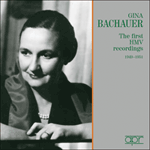
Welcome to Hyperion Records, a British classical label devoted to presenting high-quality recordings of music of all styles and from all periods from the twelfth century to the twenty-first.
Hyperion offers both CDs, and downloads in a number of formats. The site is also available in several languages.
Please use the dropdown buttons to set your preferred options, or use the checkbox to accept the defaults.

| Gina Bachauer (piano), The New London Orchestra, Alec Sherman (conductor)» More |
The work contains many stylistically striking passages, especially in the outer movements. After the second theme in the solo exposition, where Mozart usually builds immediately towards a virtuosic climax for the piano culminating in a cadential trill in the dominant key to mark the end of the first half of the movement, here he introduces ruminative contrapuntal contemplation for the piano by itself. The demonstration of solo virtuosity is thereby made to wait. And close to the end of the movement a dramatic passage, new to the recapitulation relative to the exposition, shunts the music temporarily to G minor and includes terse diminished chords before harmonic preparation for the end of the recapitulation is resumed.
The finale, another sonata rondo, initiates its development section with a compact, audacious move from the dominant of B minor to a confirmation of B flat major just a few bars later, invoking a comparable harmonic process at the onset of the development section of the first movement of the final piano concerto, K595 in B flat. The middle movement, in ABA form, is a more modest affair, including a central section in which piano interaction with the orchestra is minimal and opportunities to promote (and embellish) the aria-like melody can be exploited by the soloist.
from notes by Simon P Keefe © 2017
L’oeuvre contient de nombreux passages remarquables sur le plan stylistique, en particulier dans les mouvements extérieurs. Après le second thème de l’exposition, où, généralement, l’on se dirige immédiatement vers le climax virtuose avec un trille cadentiel à la dominante pour marquer la fin de la première partie du mouvement, Mozart introduit une contemplation contrapuntique méditative au piano. La démonstration de virtuosité se fait ainsi attendre. Vers la fin du mouvement, un passage dramatique, qui apporte un matériau nouveau, mène temporairement à sol mineur et comporte des accords diminuées tendus avant que soit reprise la préparation harmonique pour la fin de la réexposition.
Le mouvement final, également un rondo, initie son développement avec un mouvement compact et audacieux de la dominante de si mineur jusqu’à la confirmation de si bémol majeur quelques mesures plus loin, faisant appel à un processus harmonique comparable à celui du début du développement du premier mouvement du dernier concerto pour piano, K595 en si bémol. Le mouvement central, de forme ABA, est de facture plus modeste, où, dans la section centrale, l’interaction du piano et de l’orchestre est minimale et les opportunités de mettre en valeur (et d’embellir) la mélodie de type aria peuvent être exploitées par le soliste.
extrait des notes rédigées par Simon P Keefe © 2017
Français: Catherine Meeùs
Das Werk enthält viele stilistisch auffällige Passagen, vor allem in den Ecksätzen. Nach dem zweiten Thema in der Solo-Exposition, wo Mozart in der Regel sofort einen virtuoser Höhepunkt für das Klavier im Blick hat, der in einem Kadenztriller auf der Dominante gipfelt, um das Ende der ersten Hälfte des Satzes zu markieren, führt er hier grüblerische, kontrapunktische Kontemplation für das Klavier allein ein. Die Darstellung der solistischen Virtuosität muss erst einmal warten. Und nahe dem Ende des Satzes in der Reprise führt eine im Vergleich zur Exposition neue dramatische Passage die Musik zeitweise nach g-Moll und enthält knappe verminderte Akkorde, bevor die harmonische Vorbereitung auf das Ende der Reprise wieder aufgenommen wird.
Das Finale, wiederum ein Sonatenrondo, eröffnet seinen Durchführungsteil mit einer kompakten, kühnen Wendung von der Dominante von h-Moll zur Festigung von B-Dur nur wenige Takte später und weckt Erinnerungen an einen vergleichbaren harmonischen Prozess am Beginn des Durchführungsteils des ersten Satzes des letzten Klavierkonzerts KV 595. Der Mittelsatz in ABA-Form ist eine etwas einfachere Angelegenheit, die einen zentralen Abschnitt umfasst, in dem die Interaktion zwischen dem Klavier und dem Orchester auf ein Minimum reduziert ist, und wo der Solist alle Möglichkeiten ausschöpfen kann, die arienhafte Melodie hervorzuheben (und auszugestalten).
aus dem Begleittext von Simon P Keefe © 2017
Deutsch: Jan Ritterstaedt
 Gina Bachauer - The first HMV recordings Gina Bachauer - The first HMV recordings'Here is a noble tribute to a noble pianist. Gina Bachauer (1913-76) was an artist whose exultant virtuosity and unswerving musical honesty became one ...» More |

